
OC 949-428-4500
LA 310-460-2444
(The following is a transcription of the above video)
Today we’re here to talk about cystic acne, both what we know about the causes of cystic acne, the active condition where you have active cysts on your face and in your skin, and also what we do about the scarring that occurs after the cysts have gone away and your skin has all sorts of pockmarks on it.As a matter of fact, acne has been around since the days of the Egyptians. Literally, there are all sorts of archeological findings that indicate that cystic acne was an issue all the way back then.
Even so, over the last 4,000 years, we haven’t figured out what the real systemic causes of cystic acne are.We know for sure that it has something to do, in most cases, with sex hormones because when people go through puberty, the acne shows up, but not everyone gets it. Even though everyone goes through that stage, not everyone gets cystic acne.
We even have cases in our medical practice of identical twins. They live in the same home, they eat the same food, they go to the same school, obviously they have the same parents, and yet one of them has cystic acne and the other one doesn’t. Go figure.
We really don’t know, at a systemic level, what causes cystic acne.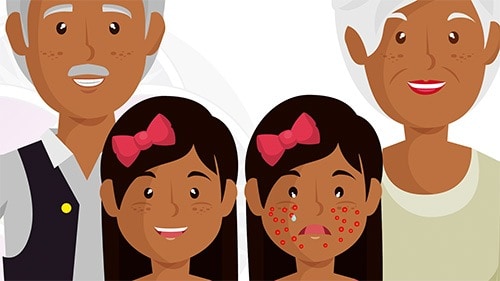
There are a couple of subjects that are often associated with cystic acne that we’re only going to touch on briefly here.
One of them is hygiene. I’m going to assume that all of you with cystic acne out there are already taking good care of your skin, in regards to hygiene.
The other is diet. You may know that there are three food groups that do have an effect on some people with cystic acne, and I’m assuming that you’ve already done some experimentation with your diet to see if eliminating those items might help your skin.
One of them is milk products, and that would be cow milk, anything with cow milk in it. The other of course is going to be sugar, refined sugar, and the third one for a very few people is the glutens.
So I’m hoping that you’ve already done some experimentation with that, to see if that can help your skin condition.Now this also applies to adult onset cystic acne. You may be 25, 35, even 45 years old, never having had acne as a teenager, and suddenly one day wake up and, boom, cystic acne all over the place.
For women, this might be an issue of sex hormones, and of course if that’s the case, you have to have that checked out.
The bottom line is this, especially for adults, we do not know the cause of cystic acne, but we certainly know locally how to deal with it, how to treat the cysts, and how to solve the cystic acne scarring.Before we get into the details how how to treat the cystic acne, we need to take a deep dive into the physiology of your skin and go through its various components so we can see where your cysts are actually coming from.
So here we are, we’re looking at a diagram of an idealized version of the skin (see above animation).
The bottom layer, the yellow layer, is the subcutaneous fat. That does not have any effect on acne, so we’re going to ignore it.
The skin itself is comprised of that thick layer right above the fat. That’s called the dermis.

What is the dermis made out of?
Well, here we have sweat glands (see above animation). You can see those. Here, obviously, you have a hair and then the hair follicle down underneath it. That round thing at the very bottom of the hair follicle is called the papilla or the root of the hair.
By the way, there are lasers that can target that papilla and disable it so that the hair never grows again, and that’s what laser hair removal is all about.Now, all that white stuff in there, that’s the collagen matrix of the skin. Collagen is, let me tell you, it is a miracle of engineering. It’s extraordinary.
There are many different types of collagen in the body. We’re going to focus on the collagen right here in the dermal matrix. It’s called collagen type one.
As I mentioned, it’s a miracle that gives all the structural integrity of your skin and all those wonderful characteristics to your skin. It’s all in the collagen.
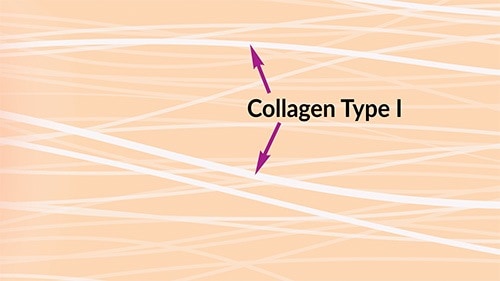
Now, collagen itself is a very thin protein fiber. It’s a little tiny little thing. For its weight and its size, it’s actually stronger than steel, but it is so small that by itself it cannot confer any of the amazing physical characteristics of your skin. Your body, your physiology, takes those little fibers and puts them through a four phased engineering transformation.
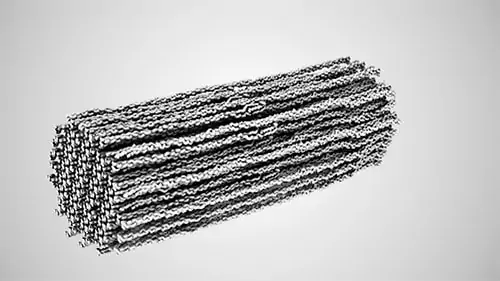
First it takes those fibers and knits them together into a very tight basket weave. Then chemically, it bonds those fibers together into bundles. Then it takes those bundles and layers them in laminar layers, one on top of another like plywood. As you know, plywood is even stronger than the wood it’s made out of, and thus, too, your skin is incredibly strong.
Then it takes those laminar layers and braids them three-dimensionally every which way, in and out. Looking at it under a microscope, it is beautiful.
The bottom line is that the skin is not only incredibly strong, it’s elastic and flexible and stretchable and resilient and toned and full and tight and lifted and youthful and sexy. It’s all about the collagen: how much you got and what shape is it in?
As a matter of fact, it’s this collagen matrix that has been damaged by cystic acne.
So let’s take a look again.
We have arteries and veins down there (see above animation), and then right there, that’s the antagonist in our story. That is a sebaceous gland. Every pore in your skin, whether there’s a hair in it or not, has a sebaceous gland.
The sebaceous gland is what makes sebum or the oils for your skin. The oils come up through the pores, and they get absorbed in that very, very top layer of the epidermis, which is dead. It’s the dead layer called the stratum corneum. It fills that stratum corneum layer and basically makes an oil mantle around your body to protect you. That’s why water just beads off your skin, because of the oils in that stratum corneum, that dead layer.
Now, if your sebaceous glands are overactive, you’re going to have oily skin. If your sebaceous glands are under-active, you’re going to have dry flaky skin.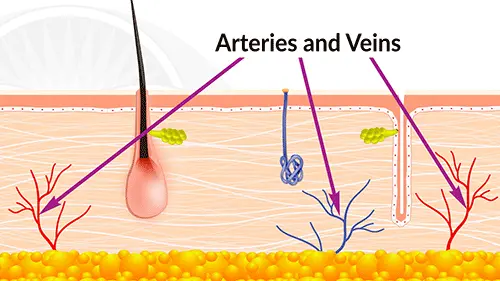

For reasons again that no one really understands, an overactive sebaceous gland can also become oversized.
It can balloon up, just like that (see above image), and that very cute little sebaceous gland can become a monster sebaceous cyst. That sebaceous cyst is in fact the cyst of cystic acne. When you have cystic acne, that’s what’s filling up your skin.So here you are, you have cystic acne. You know that your sebaceous glands have ballooned up. Now you have these bumps in your skin, and we need to treat it.
First we have to understand how your body is reacting to that sebaceous gland that has mysteriously ballooned up.
As you can imagine, this thing ballooning up in your skin causes quite an irritation in your skin. Your immune system that is monitoring your entire body senses this thing ballooning up in your skin, and it responds to it.Imagine in fact that you’re sitting in the central control room of your immune system, and the alarms go off. Something is growing in this kid’s skin, or something is growing in this adult’s skin. These foreign bodies are ballooning up, and so the immune system reacts with an immune inflammatory response.
As you may recall, and you may be going through this right now, that sometimes you can feel that cyst just beginning under your skin. It’s a hard little nodule, like a little hard pea, and by the next morning when you wake up, your little tiny pea has ballooned up. It’s become swollen and red and painful. That’s the inflammatory response.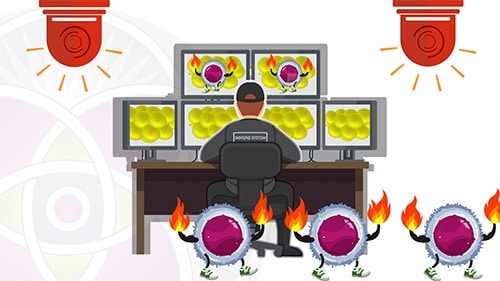
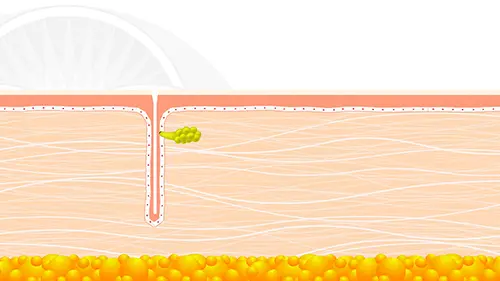
Let me draw it out so you get a better picture of what’s going on (see below animation). Here we have the epidermis, underneath it we have the dermis, and underneath that we have the subcutaneous fat. Now we have a pore, and then of course the cute little sebaceous gland.
Now this little cute sebaceous gland, again for reasons that no one quite understands, can balloon up and become a monster sebaceous cyst. Now of course, the epidermis is distended way above it, and it’s all red and swollen and painful. You guys know all about this.Now, how did it get big, red, and swollen? That’s the immune inflammatory response.
The alarms went off, and the immune system initiated an inflammatory response. All these red blood vessels grew into the area (see above image), in order to bring with them and to carry with them, all the immune cells that are going to attack this foreign thing that’s growing in your skin. The immune modulators and mediators are all now there.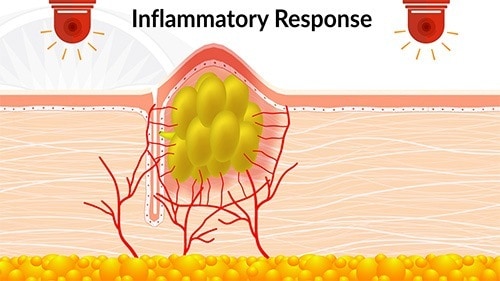
That’s the condition that exists in active cystic acne. You have these oversized sebaceous glands, these overactive sebaceous glands. The immune system has reacted or responded to this, and now the cysts are inflamed and they’re swollen and they’re big and red and pustular and painful. This of course can happen pretty much anywhere on our body, but mainly the main issue is in our faces and our chests and our backs.
If your natural immune system and your immune response can’t deal effectively with these cysts pretty quickly and the cystic condition persists for a long time, eventually this will turn into scarring, but we’ll get to that in a minute. Right now, we have an active cystic condition, and the question is how do we deal with it?
I’m assuming of course that all of you out there with cystic acne have probably been to a doctor or two, to try to deal with this. You might’ve gone to a dermatologist or a conventional family practice, and generally speaking, the doctor is going to draw out two circles for you to explain to you what’s going on.
The first circle that they will draw is the active cystic condition, and right next to it another circle, which is the scarring (see above image).
The doctor’s going to say, “You know what, you can’t really deal with the scarring while the cystic acne is still happening.” Which makes sense. Why try to deal with the scarring while your skin is still filled with cysts and making more scars?So the doctor will say “you have to deal with the active cystic condition first, before we can deal with the scarring.”
Well, that’s the conventional model, but I’m happy to say that Dr. Pien and I, after 20 years of doing research in this area and treating tens of thousands of people with cystic acne, we have found that the protocols that we use, primarily with lasers and other modalities as well, can in fact take those two circles and overlap them.
The diagram now looks like this (see above image), with the active circle overlapping with the scarring circle. If you deal, with the protocols that we’ve developed here, with the active circle, the active cystic condition, you’re pretty much taking care of half of the other circle, which is the scarring condition.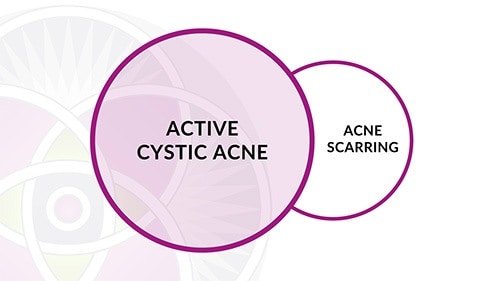
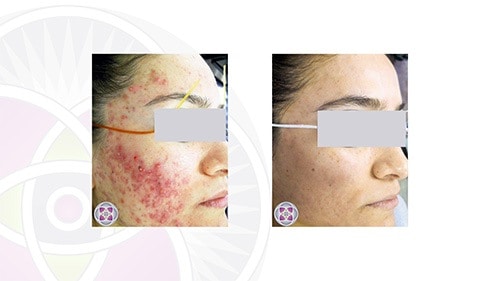
Here are some before and after photographs of successful treatments of cystic acne, when we caught it early enough so that the scarring resolved on its own.
So what did we do? What are the protocols that deal so effectively with the active cysts, that also initiates and takes care of pretty much half the scarring? Again, we’ll talk about the scarring later.
Before we jump into the details of the protocols that we have developed with lasers, as well as the additional modalities that we’ll talk about later, let’s first talk about the conventional approach to dealing with cystic acne. Basically what we’re talking about here are medications or pharmaceuticals. They fall into three different groups: antibiotics, hormones, and something called Accutane.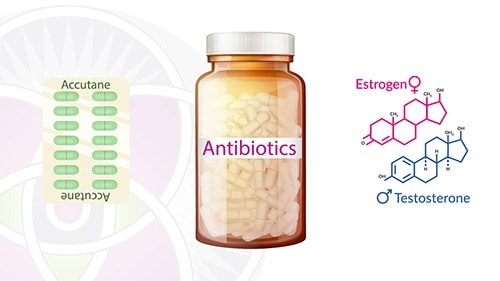
There is a misconception out there, just like the misconception that somehow we really understand the systemic causes of cystic acne, when we don’t. There is also the misconception that cystic acne is an infectious condition, that you have infections in your skin.
As a matter of fact, cystic acne is not an infection. Not an infection, you say? Then what is all that pus-y white stuff that I’m squeezing out of there? Doesn’t that look like an infection?Well, let me explain to you what that pus-y white stuff is.
The sebaceous gland, when it becomes oversized and overactive, looks like this (see above image). The inside lining of the sebaceous gland has modified epithelial cells in there, whose job it is to make the sebum for your skin, the oils for your skin.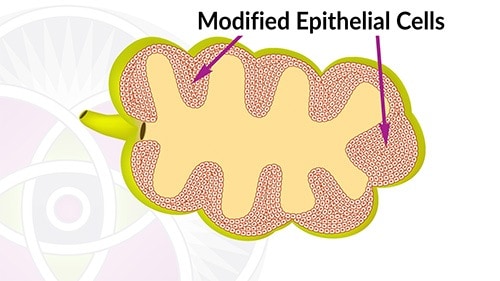

In an overactive gland, not only are these cells making way too much oil, or way too much sebum (see above image), but the gland itself is making way too many of these cells.
Those cells are quickly dying, falling off, filling the inside of the gland, and are being mixed with that sebum. That white pus-y stuff that looks like an infection is actually a collection of dead epithelial cells mixed with the sebum, that when you squeeze out is white and pus-y and looks like an infection. But it is not.As a matter of fact, for all of you out there that have tried antibiotics, you know from your own experience that it’s not an infection. Because if it was an infection, the antibiotics would have worked every single time, not only with you, but everyone else out there that has cystic acne.
But oh my gosh, all you got to do is go to a high school and you’ll say, “This can’t be an infection because antibiotics are available to everyone, and all these kids have cystic acne.”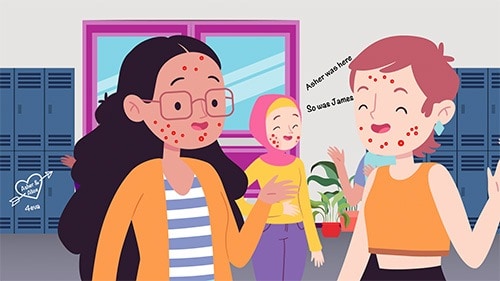
It’s not because of the antibiotic’s antibacterial activity, it’s because that some antibiotics also have an anti-inflammatory property.
Given that we know, we’ve been through this, that we know that these cysts have now become inflamed because of the immune system’s response, the antibiotics reduce some of the inflammation, and that helps the cystic acne.
I must mention, longterm use of antibiotics is not only ineffective, but can cause very serious negative effects in other physiological systems of our body.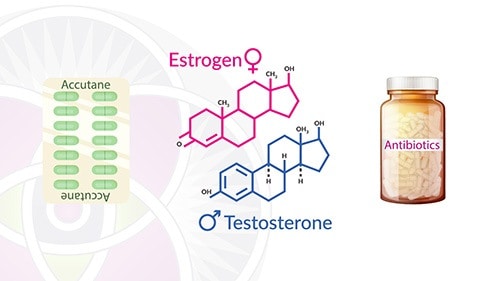
The second class of drugs or medications that can help of course are those associated with sex hormones.
We do know, of course, that sex hormones must have something to do with cystic acne, because many people get it when they’re going through puberty and the sex hormones are now increasing in their bodies.
We also know that for some women in adulthood, they may have an increase of some sex hormones that may have something to do with their cystic acne.Therefore, there are some medications that do affect the hormonal landscape of our bodies and can help with cystic acne. For women in particular, that’s the birth control pill. Obviously that doesn’t help guys.
For both men and women, there are some medications that do interact or interfere with the sex hormones’ effect on sebaceous gland activity. Spironolactone is one of those medications.
Once again, if cystic acne was only an issue of hormonal activity, we would have solved that a long time ago. Obviously that has not happened, so we get right back to square one. We don’t really understand what the systemic conditions are that make a person have cystic acne.The third category of medications, of pharmaceuticals, that are commonly used for cystic acne is the drug Accutane.
Don’t know how else to say it, so I’m just going to say it. Accutane is a very dangerous and very nasty drug. It should be considered the last resort of last resorts because it has so many negative side effects, particularly on brain and on liver. The list is as long as my arm and they’re very, very dangerous.
If you’re going to go that route, you have to be sure to get a prescription from a doctor that knows how to monitor you. Knows how to monitor both your brain functions and your liver functions in order to be sure that you’re not being negatively affected by the drug itself.
We don’t prescribe Accutane in our practice.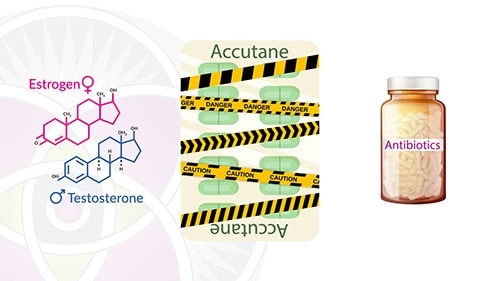
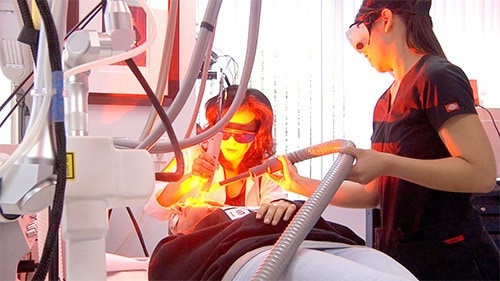
Now that we have reviewed the things that sort of work or work a little bit, what are the things that really work consistently and very effectively?
Now we get to the laser protocols and the integrative modalities that we have developed here.
By the way, I don’t expect all of you in the world that have cystic acne to come here. Obviously that’s impossible. I’m going to explain these protocols to you so that you can find physicians in your area of the world that hopefully have these modalities, have these energies and these lasers, and can use these protocols on you wherever you live.Here we are with the skin, with an oversized, over-exuberant, overactive sebaceous gland. There are different kinds of lasers that can interact very effectively with this oversized sebaceous gland.
The gold standard is a laser called the Nd:YAG, with a frequency of 1064 nanometers. It’s an infrared laser, and the energy of that laser will get collected and concentrated inside that gland.
Basically, that laser energy will penetrate into that sebaceous oversized cyst. It will concentrate in that cyst and slap it into submission, dry it up, and shrink it back down.
It’s not the only laser that does that, it’s not the only frequency that works, but that is the best of all of them.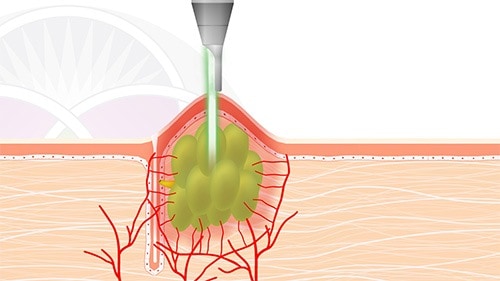
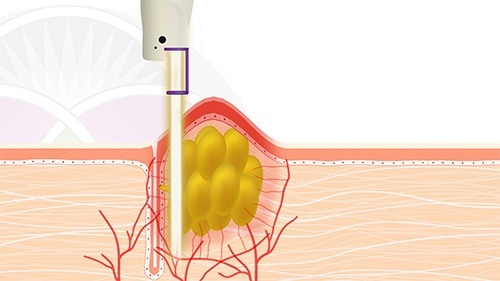
The other issue we have to deal with, of course, is all that inflammation that occurs in this cyst, all that inflammatory tissue that surrounds the cyst that we talked about earlier. That, too, has to be treated.
For that, we would use a different class of lasers, vascular lasers, that interact with all that red vasculature.The third laser that we might use, often do with cystic acne, is an ablative laser.
Let’s take a look at the top layer of the skin, the epidermis (see above animation).
This is the live part of the epidermis, filled with live epithelial cells. Right above it is that dead layer that we talked about before, in which all the oils get absorbed. That dead layer can sometimes fill up the pores and plug them up.
Now that we are causing those glands, those sebaceous cysts to shrink down, all that gunk in there has got to go someplace. It’s got to come out. In order for this gunk to get out, if we take off that top dead layer of the skin that might be plugging up the pores, that gunk can get out easier.
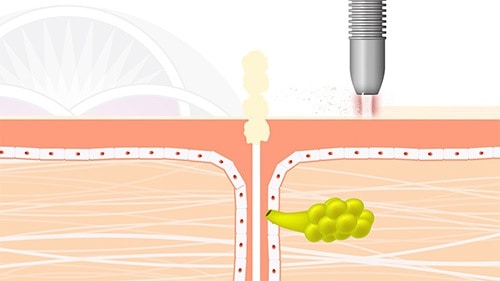
A very light epithelial peel will open up those pores and allow the purging to happen more easily.
Some people get really lucky, and the body dissolves away that gunk internally, so there’s no purge. Those are the lucky ones.
But for many, as those glands shrink back down, as those cysts dry up and shrink back down, the gunk’s got to come out, and you’re going to purge. Taking that dead stratum corneum layer off is going to help that process.So those three lasers used together, the laser that interacts with the sebaceous glands, the laser that interacts with the vasculature and the inflammation, and an ablative laser that will take off the stratum corneum so the skin can breathe, these three classes of lasers used together in a combination, with our additional modalities that I’ll discuss later, are a very effective treatment for cystic acne.
Now, I haven’t talked about how to set those lasers up, what kind of power needs to be used, how to modulate those energies, and things like that. That’s way too complicated for this conversation, and if any of your doctors anywhere in the world need to know more about it, they’re welcome to contact me. I’ll explain to them precisely the protocols of how to modulate those lasers, which sequence to use them in, in order to get a very good result in your skin.
So that’s what an individual treatment looks like, the combination of those three lasers.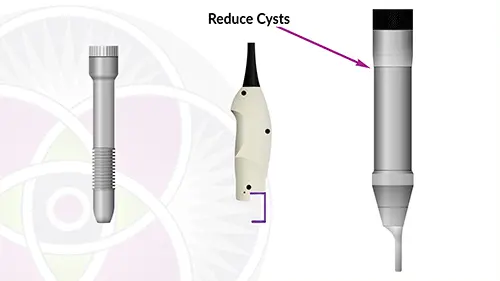
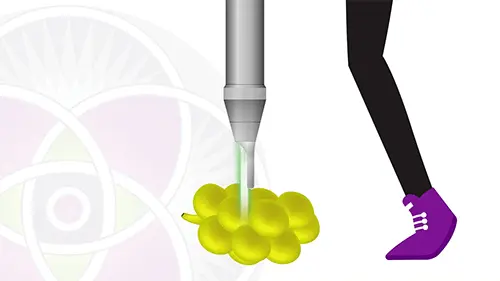
Now the question is, how many treatments do I need, and how much time between the treatments?
This is actually quite simple, but extremely important. The time between treatments needs to be three weeks and no more than four weeks. Why is that?
Remember the old adage of don’t kick a man when he’s down? We’ll, in the case of sebaceous cysts, once you get them down, you want to kick them over and over and over again.
If you wait too long between treatments, the sebaceous cysts sometimes have the ability to get back up. You don’t want that to happen. You want to come in for treatments every three weeks, ideally, no more than four weeks.The bottom line is this, and the data is very clear on this, the longer we can subdue those sebaceous glands, the less chance they have of resurrecting themselves and getting back up. So we want to keep them down for as long as necessary, without giving them the chance to get back up.
Now, how many treatments would you need depends on the severity of your cystic acne condition and the responsiveness of your physiology. Generally speaking, between three and five treatments every three to four weeks is going to take care of your cystic acne.
Those are the lucky ones, who haven’t gotten any scarring yet.For those of you out there whose cystic acne is much worse, or you’ve had it for a longer period of time and your skin is already beginning to scar, let’s talk about that. Let me explain to you what is causing that scarring and what the structures of those scars are inside your skin.
Let’s imagine once again that you’re sitting in the central control headquarters of the immune system. You’ve already sent your immune army over to these cysts, to deal with whatever that thing is that’s growing in your skin.Now, the immune system expects that within a week or two those cysts will have gone away because your army would have dealt with them. But here it is, two, three, four weeks, a month later, maybe two months later, and the cysts are still there.
From the perspective of your immune system, “Hey, I sent my army over there to deal with whatever that thing is that’s growing in the skin, and it’s still there. Obviously my immune army couldn’t deal with it. Even though I don’t know what it is for sure, I don’t want it to spread. I need to wall it off.”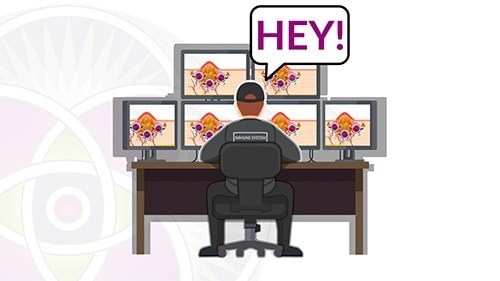

As a matter of fact, all this inflammatory tissue that surrounds the cyst slowly but surely becomes a scar tissue (see above image), and the scar tissue encapsulates the cyst, walls it off, in fact, we now technically call this cyst an encapsulated cyst.
So now, why is that a problem? How come that causes the cystic scarring that we see, the pockmarks, the rolling pockmarks, and the boxcar pockmarks?
Well, this is why.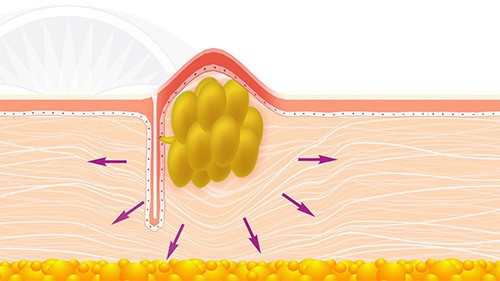
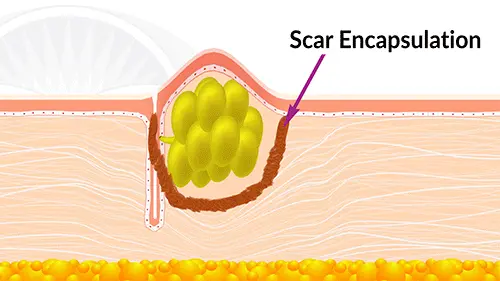
This scar encapsulation has been created, and all that good tissue is now on the other side of the wall.
When that cyst eventually dries up and goes away, and they all do, all that good material, all that good tissue that used to occupy that space where the cyst was, is on the other side of the wall and can’t get into where it used to be. So the skin now collapses down inside the scar (see above animation), and you are left with, voila, a pockmark.
As you can see, the pockmark is lined with the scarring that encapsulated the cyst.Okay, so here we are. Your skin now has cystic acne pockmarks, and once again, lasers and a few additional modalities that we’ll address at the end of the video come to our rescue.
In your dermis, in your collagen matrix, there are cells called fibroblasts (see above image) whose job it is to deal with the maintenance and repair of the collagen matrix. They generate new collagen, they repair damaged collagen, and overall the maintenance of the collagen matrix so that your skin is healthy and young and tight and beautiful, is the job of these fibroblasts.
The most effective way to stimulate the dermal matrix and all these fibroblasts to regenerate new healthy skin for you includes four different types of lasers.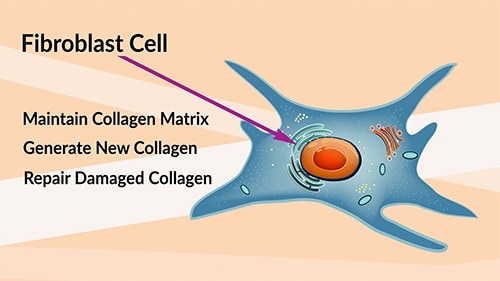
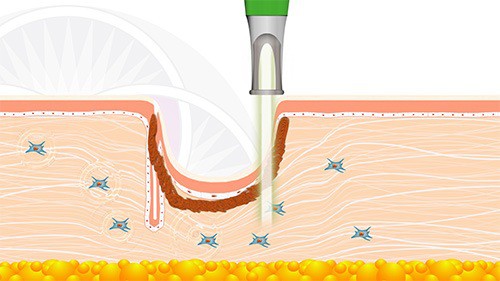
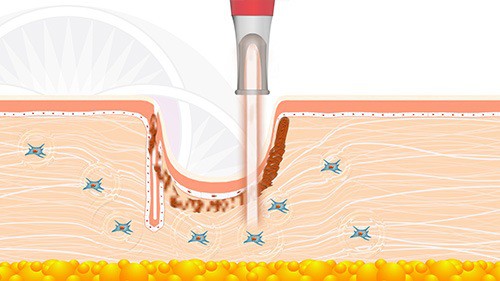
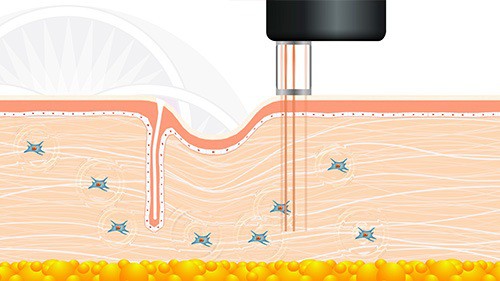
The third type of laser has it beam which is fractionated, which means the beam is broken into tiny micro columns of energy that are so small they are measured in microns.
The geometry of this kind of energy causes the skin to contract. This is particularly important so that the pockmarks close in from all sides, like the lens of a camera.The fourth type of laser is a resurfacing laser. This is particularly important to make sure that the surface of your skin is smooth and with a beautiful texture.
Those four classes of lasers, those that cause stimulation and regeneration of new collagen, those that cause contraction of the collagen matrix, those that can break down the scar tissue collagen, and those that can resurface your skin, all used together in a customized protocol, in addition to our integrative modalities, are a very effective protocol for treating your scars.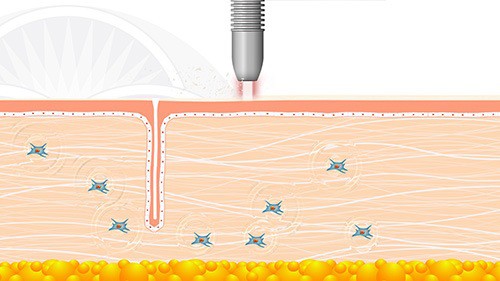
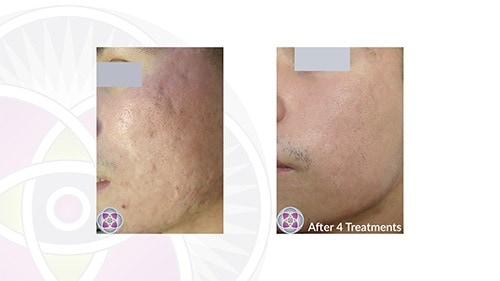
Once again the question now is, how many treatments will I need and how much time between the treatments? Well, how many treatments you’ll need depends on the severity of your scarring, and of course the responsiveness of your own physiology.
Generally speaking, between three and five treatments will transform the scarring of your skin.
Now, the time between the treatment is much longer than the time between the treatments when we were dealing with active cysts.Your skin’s ability to make new collagen, the activity of the fibroblasts cells, takes much longer. That’s why I explained to you previously the amazing complexity and intricacy of the design of the collagen matrix. That, the skin cannot make overnight. It’s very complex, and it takes the skin weeks to generate that.
We will do the stimulation with the lasers to get all that machinery going again, but your skin must work 24/7 for many weeks to actually make the new collagen matrix that’s going to repair your skin.
Generally speaking, you will do these treatments between six to eight weeks, maybe even as many as 10 weeks between treatments.So there you have it. Those four classes of lasers, a series of treatments, anywhere from eight to ten weeks apart, can do wonders for stimulating the natural regenerative machinery that’s already inherent in your skin, to make new, beautiful, healthy, young and gorgeous skin.
It is, in effect, a regenerative process. We’re not doing the fixing. Your physiology is doing the work. We are simply stimulating your physiology to get busy and get it done fast.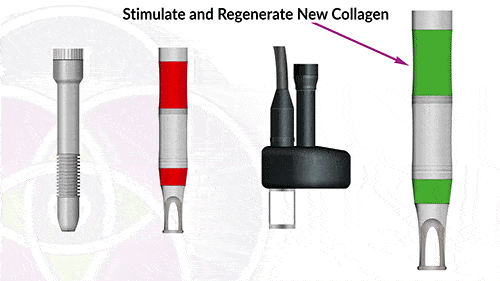
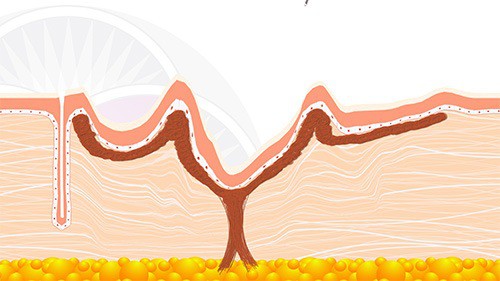
A number of times, through our description of exactly how we use laser modalities to treat both active cystic acne and scars, the scars left from cystic acne, I’ve mentioned the other integrative modalities that we use.
This is particularly important in very complicated cases, where the scarring can be very severe.
Sometimes encapsulated cysts that are right next to each other end up coalescing into huge cysts that leave very convoluted and complicated scarring. These are called boxcar and rolling scars.
Sometimes, these complicated scars even develop adhesions (see above image), where the scar tissue penetrates down below this skin, like roots that hold the skin down and pulling it down, creating dimpling.When this happens, the treatment needs to include a procedure called subcision, wherein these adhesions are released, cut through with a special needle, and injections of ozone that not only release the adhesions but also stimulate the remodeling of the adhesion scars into healthy collagen.
As you can see from the image above, as soon as the adhesions are released, the skin will pop back up and float freely, so that it can be remodeled and regenerated.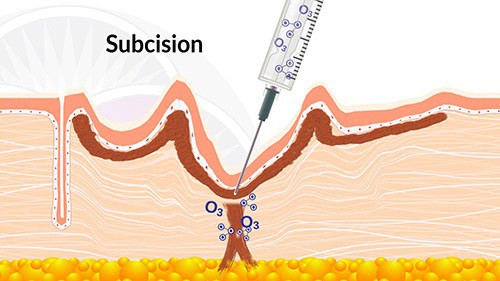
The other integrative modalities that we use include the ozone, as I just mentioned, also micro-needling, also radio-frequency micro-needling energy devices, as well as PRP, you may have heard of that, and physiological regulating medicine, which include very important anti inflammatory elements, such as specific interleukins. These are very important for the treatment of active and inflamed cysts.
At times, we might also use formulations of salicylic acid and hyaluronic acid, which help release the sebum when the skin needs to purge.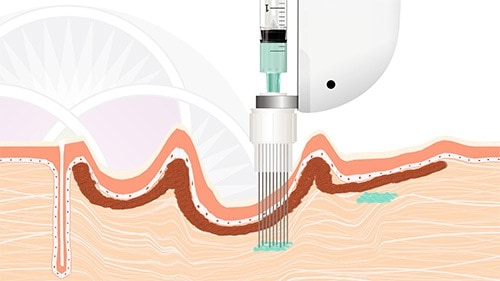
For very severe cases of scarring, we even use very specific placental allograft tissues such as Placental/Umbilical Tissues/Biological Allografts (FDA: HCT/P – Stem Cells) and exosomes. These are at the heart of regenerative medicine and a very powerful stimulant of the generation of new, healthy, beautiful skin.
All of these elements need to be injected into the skin, which can be done manually. We might also use very sophisticated computerized injection platforms that can inject very precise quantities of all these elements to very specific and precise depths in the skin.These are some of the modalities that we combine with lasers, and all the research that we do here, in treating all sorts of scarred skin, from burn patients to traumatic scars, to surgical scars, and of course the cystic acne that we’ve been talking about.
Bottom line, whatever kind of scarring you have, from cystic acne, to stretch marks, to traumatic and surgical scars, to even burn scars, your skin has innately the regenerative capacity and the machinery to fix itself, to generate new, healthy, beautiful skin. In collaboration with our technologies and our protocols, your skin can be transformed.All of us here at AMA Regenerative Medicine and Skincare, Dr. Pien and myself, and all of our nurses and our staff, we hope that this has given you more than just hope, but given you confidence that you don’t have to live with this for the rest of your life.
If you have found this to be helpful and educational, and now that you understand what’s going on with your condition, and hopefully you have hope and confidence, please share it with other people in your life that have cystic acne, or the scarring from cystic acne.
Let them know that they, too, can have more than just hope. They can have confidence that there is a solution for their skin issues.Doctors Alice Pien, MD and Asher Milgrom, Phd are established pioneers in the fields of Regenerative Medicine and Skincare. Their expertise ranges from advanced laser systems to HCT/P – Stem Cell medicine. Their medical education and advanced certifications span from medical schools of NY State University, the University of Chicago, to Johns Hopkins, Harvard and UCLA. They approach medicine with the clinical expertise of over 85,000 successful treatments over the past 20 years and significant scientific research resulting in proprietary protocols that they customize for each individual patient.
AMA Regenerative Medicine & Skincare | 1570 Brookhollow Dr., Santa Ana, CA 92705 | 6310 San Vicente Blvd STE 285, Los Angeles, CA, 90048 | Privacy Policy